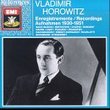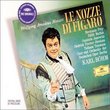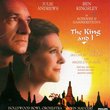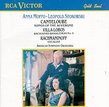| All Artists: Anton Bruckner, Wilhelm Furtwängler, Berlin Philharmonic Chorus Title: Symphony 8 1949 Members Wishing: 0 Total Copies: 0 Label: Testament UK Release Date: 4/14/1998 Album Type: Import Genre: Classical Styles: Historical Periods, Modern, 20th, & 21st Century, Symphonies Number of Discs: 1 SwapaCD Credits: 1 UPC: 749677114329 |
Search - Anton Bruckner, Wilhelm Furtwängler, Berlin Philharmonic Chorus :: Symphony 8 1949
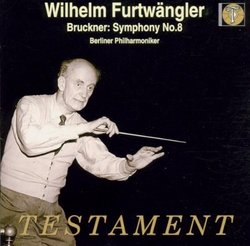 | Anton Bruckner, Wilhelm Furtwängler, Berlin Philharmonic Chorus Symphony 8 1949 Genre: Classical
Even those relatively immune to Wilhelm Furtwängler's conducting of the classics admit that his Bruckner stands with the finest ever recorded. That describes this Eighth, recorded live in March, 1949 (but without an... more » |
Larger Image |
CD DetailsSynopsis
Amazon.com Even those relatively immune to Wilhelm Furtwängler's conducting of the classics admit that his Bruckner stands with the finest ever recorded. That describes this Eighth, recorded live in March, 1949 (but without an audience present) for broadcast recording. Like most of Furtwangler's nonstudio recordings, it bristles with fervor. The slow movement, especially, has a humanity barely approached by most rivals. Of his several Bruckner Eighths on record this one is the most successful in its blend of sustained long lines and improvisatory detail. Furtwangler's command of structure and the intensity of his reading make this vital for all Bruckner fans. The sound is satisfying, despite some graininess and occassional congestion. --Dan Davis Similarly Requested CDs
|
CD ReviewsDefinitive Quality Sound Recording Of B's 8 by Furtwaengler! Thomas F. Bertonneau | 10/18/1998 (5 out of 5 stars) "Recently I made a careful study of the two performances of the Bruckner Eighth that were conducted by the great artist, Wilhelm Furtwaengler, in Berlin in April of 1949. The readings were done one day apart: on the 14th (the present Testament CD release) at the Municipality House, Berlin-Dahlem, and on the 15th of April at the Titania-Palast, a large motion picture theatre employed for the subscription concerts of the Berlin Philharmonic (since the old Philharmonie had been bombed to rubble during the War.) In ten pages or so of analysis, which I posted on an internet newsgroup, I gave my review of the qualities of both recordings. For the technical aspect of sound, this Testament release wins hands down! The performance is strong, dramatic, and yet careful, without the will-o-the-wisp momentary inspirations that sometimes came to Furtwaengler in front of a receptive audience. As a former recording engineer and historian of sound techniques, I noted that the "Magnetophon" tape recording was wide range, with crisp, generally clean highs, and powerful low frequencies. The radio engineer who made the tape adjusted the volume so that the soft passages would be audible during typical reception, so the hushed moments are boosted and somewhat out of proportion to the original intentions of the conductor. Yet, the transfer by Testament's digital engineer Paul Baily is very fine, with honest monaural sound, properly edited (unlike previous LP issues.) The performance given the following day is an entirely DIFFERENT concept: wilder and more dramatice, it is faster and has greater intensity. Unfortunately, THAT taping was very distorted on all passages above about mezzo-forte: so much so that I find it a trial to the ear, despite the best efforts of the very skilled technicians at EMI records (it is contained in an interesting 3-CD set of historic Bruckner conducted by Furtwaengler, von Haussegger, and Kabasta, on EMI Classics 7234 5 66210 2 2.)So, if you want the better overall recording of Furtwaengler's orchestra, I recommend this present TESTAMENT release: another fine effort from one of the "purist" historical reissue labels." Cathedral Architecture in Sound Thomas F. Bertonneau | Oswego, NY United States | 11/24/2000 (5 out of 5 stars) "Among producers of historical re-issues, Testament ranks high, and in the case of Wilhelm Furtwängler's 1949 Bruckner Eighth Symphony, they have done music-lovers an exceptionally fine service. While Furtwängler made relatively few commercial recordings, German radio engineers before and during and after the war recorded many of his concerts for delayed broadcast. From 1942, the chosen medium for these archival documents was magnetic tape. While not precisely high fidelity, the wartime tapes demonstrate acceptable sound; the situation improves somewhat after the war, with better equipment coming on-line. Perhaps the best-known and most spectacular of these recorded concerts is the 1951 Brahms First Symphony from North German Radio in Hamburg, but given the possibilities of contemporary digital remastering, a large number of these tapes have at last yielded their precious inner secrets. This is especially true of Testament's digital re-recording of the 14 March 1949 Berlin Bruckner performance, a so-called Magnetophon Concert without an audience transmitted live but also taped for subsequent re-broadcast. The quiet auditorium made for studio-like conditions. (A 15 March performance is afflicted by ubiquitous audience noise that seems to distract Furtwängler from some of his purpose.) Despite his reputation for taking Bruckner at "heavenly length," Furtwängler turns in a fairly swift reading of this mighty symphony. He keeps the Adagio under twenty-six minutes (living conductors in our day regularly stretch it to thirty or beyond); and he brings in the Finale at twenty-two minutes and fifty eight seconds (again, living interpreters take much longer.) One reason for Furtwängler's dislike of studio-sessions was their stop-and-go character, even after tape came into use. In the Magnetophon Concert, there is no starting-and-stopping. Furtwängler gives the uninterrupted performance that we hear. The engineers do no editing after the fact. This alone accounts for much of our sense of organic unity in Furtwängler's "take." What I call "swiftness" generally in regard to tempi means specifically in the case of the opening Allegro Moderato an urgency that we otherwise rarely hear in this music. Where A Georg Tintner or a Sergiu Celibidache attempts to dissolve the notes into mystical yearning, Furtwängler gives Bruckner's piety a sinewy, striving embodiment. So too in the Scherzo: It is muscular and determined rather than pastoral and jocular. John Ardoin, in "The Furtwängler Record," refers to the Tristanesque atmosphere of the Adagio. I disagree. As Furtwängler discovers, Bruckner seeks no dissolution, neither into divinity nor into eros; rather, he opens up a vast space for contemplation, like the nave of a great cathedral. Furtwängler was a reader of Oswald Spengler; Spengler said that Western music amounted to architecture in sound; that is how Furtwängler understands Bruckner's Eighth. Furtwängler's Finale gallops along quite rapidly, compared again with Celibidache or Tintner, and one gets the impression (as one did in the First Movement) of spiritual urgency rather than mystical transfiguration. (Mystical transfiguration there is, in Bruckner, aplenty - see the Ninth Symphony.) With excellent notes, this CD ought to be snapped up by Brucknerians, by Furtwänglerians, and by all those interested in historical performances from he mid-century." Possibly the best Eight ever Di Peleegrino Giuseppe | Modena, Italy | 01/13/2005 (5 out of 5 stars) "In my opinion, this recording of Furtwangler magnificent account of Bruckner's Eight Symphony is one of the finest ever made. Testament's superbly vivid recording reproduces with immediacy the texture of Furtwangler reading.
A unique interpretation, a true landmark in the history of Bruckner recording. Strongly recommended. Many thanks to Amazon reviewer Jeff Lipscomb who has recommended this recording in his extremely accurate and useful reviews." |

 Track Listings (4) - Disc #1
Track Listings (4) - Disc #1